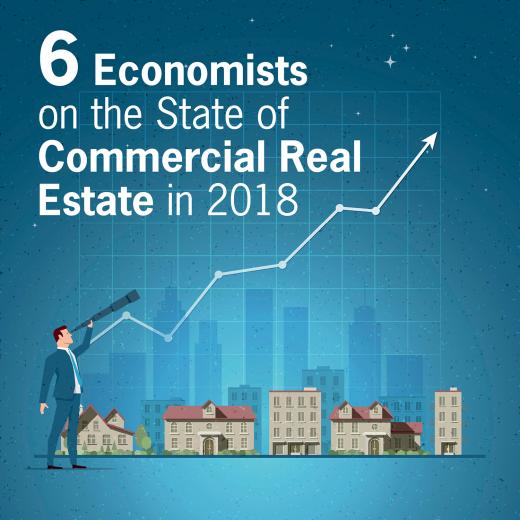1 7
1 7
Last year was largely a good one for commercial real estate investment—and 2018 promises to be strong as well. Momentum for the new year stems from a strong holiday shopping season and tax reform that is anticipated to leave many businesses and consumers with more money in their pockets. While there may be issues to keep an eye on—such as shifting consumer behavior and rising inflation and interest rates—the outlook remains positive for the short term, several real estate economists told NREI. Click though our slideshow to read their in-depth assessment of the industry’s prospects in 2018.
“I feel the industry has been too negative about our luck for the commercial real estate industry,” says Tim Wang, managing director at Clarion Partners. “We are on the more bullish side of the spectrum. We think that people are underestimating the impact of the tax reform. … We’re seeing broad-base benefits for all project sectors for that reason.” While general consensus is that real GDP this year will grow by 2.6 percent, Wang estimates it may be closer to 3.0 percent growth, which will have a trickle-down effect for the real estate industry.
Cautious optimism is the best way to describe the outlook for commercial real estate in 2018, says Heidi Learner, chief economist at Savills Studley. “There’s nothing I can point to from an economic perspective that suggests any type of slowdown, but I think it’s always a question of being mindful of risks and what’s happening generally with regard to supply and occupancy trends,” she notes. Learner also anticipates the tax reform legislation to be a net positive for the industry, but the extent of firms redeploying after-tax earnings into real estate remains unclear.
“I think the theme is continued growth, which is good, but of a moderate intensity,” says Andrew Nelson, chief economist at Colliers International. Faster economic growth—which is anticipated—should spur marginally faster absorption of commercial space. “Expect to see still robust property sales and leasing, and the tax cut on the margin will help a bit, pushing the economy and boosting property fundamentals,” Nelson notes.
“The recent tax cuts are likely to benefit real estate significantly [and] should have a far more substantial impact than either changes to immigration policy or infrastructure policy,” says Ryan Severino, chief economist at JLL. Restricting immigration could exacerbate labor shortages in construction and limit renter demand. For infrastructure, serious funding questions remain, and public-private partnerships are not a panacea. “The returns demanded by investors far exceed the cost to float municipals or government bonds to pay for infrastructure,” Severino adds.
“REITs didn’t participate in the tremendous growth of stock prices last year,” says Brad Case, senior vice president of research and industry information at Nareit. Meanwhile, technology stocks have been very aggressively priced. Now may be the time for investors to re-consider public REITs, which saw good returns last year—even if not as high as expected in a bull market, according to Case. “What you’re looking for is a market in which you can expect returns to be strong, and that’s where we are,” he notes, as REITs in 2018 are expected to continue to operate in a strong environment.
Tax reform has given the commercial real estate industry a modest boost, says Byron Carlock, U.S. real estate leader at PwC, adding that previously stalled transactions are now starting to go through. “The industry’s pretty optimistic right now. That said, people are always cautious that something could go wrong because prices are so high,” Carlock notes. Weakness remains in the retail sector, but good opportunities can be found by turning class-B and -C malls into alternative uses, he says.

